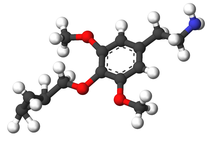Cyclopropylmescaline
Appearance
This article relies largely or entirely on a single source. (September 2019) |

| |

| |
| Names | |
|---|---|
| Preferred IUPAC name
2-[4-(Cyclopropylmethoxy)-3,5-dimethoxyphenyl]ethan-1-amine | |
| Other names
4-Cyclopropylmethoxy-3,5-methoxy-phenethylamine
4-Cyclopropylmethoxy-3,5-methoxy-1-ethane | |
| Identifiers | |
3D model (JSmol)
|
|
| ChEMBL | |
| ChemSpider | |
PubChem CID
|
|
| UNII | |
CompTox Dashboard (EPA)
|
|
| |
| |
| Properties | |
| C14H21NO3 | |
| Molar mass | 251.326 g·mol−1 |
Except where otherwise noted, data are given for materials in their standard state (at 25 °C [77 °F], 100 kPa).
| |
Cyclopropylmescaline (CPM or 4-cyclopropylmethoxy-3,5-dimethoxyphenethylamine) is a lesser-known psychedelic drug. CPM was first synthesized by Alexander Shulgin. In his book PiHKAL, the dosage range is listed as 60–80 mg and the duration listed as 12–18 hours.[1] CPM produces closed-eye imagery, visuals, and fantasies. It also causes enhancement of music.[1] Very little data exists about the pharmacological properties, metabolism, and toxicity of CPM.
See also
[edit]References
[edit]- ^ a b Shulgin, Alexander; Shulgin, Ann (September 1991). PiHKAL: A Chemical Love Story. Berkeley, California: Transform Press. ISBN 0-9630096-0-5. OCLC 25627628. CPM Entry in PiHKAL
